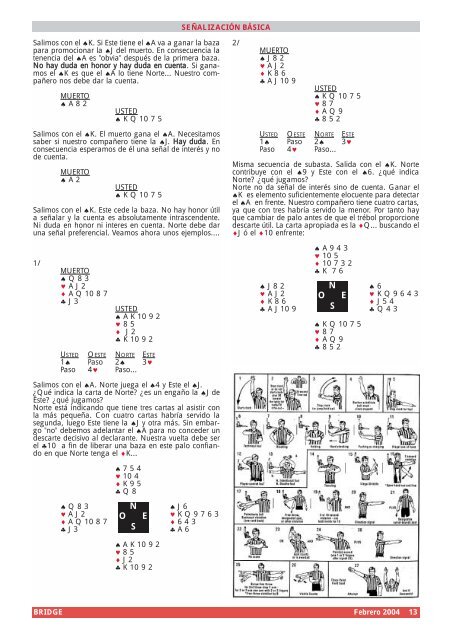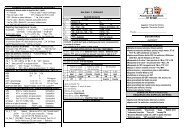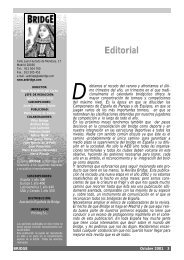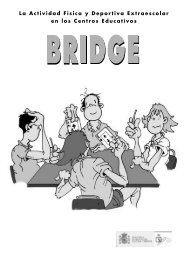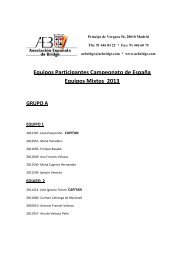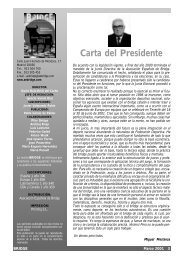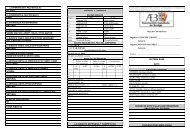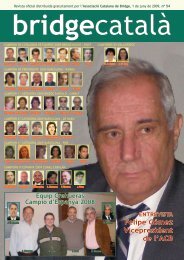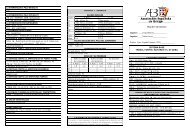milagros del carteo - Asociación Española de Bridge
milagros del carteo - Asociación Española de Bridge
milagros del carteo - Asociación Española de Bridge
You also want an ePaper? Increase the reach of your titles
YUMPU automatically turns print PDFs into web optimized ePapers that Google loves.
SEÑALIZACIÓN BÁSICA<br />
Salimos con el ♠K. Si Este tiene el ♠A va a ganar la baza<br />
para promocionar la ♠J <strong><strong>de</strong>l</strong> muerto. En consecuencia la<br />
tenencia <strong><strong>de</strong>l</strong> ♠A es "obvia" <strong>de</strong>spués <strong>de</strong> la primera baza.<br />
No hay duda en honor y hay duda en cuenta. Si ganamos<br />
el ♠K es que el ♠A lo tiene Norte... Nuestro compañero<br />
nos <strong>de</strong>be dar la cuenta.<br />
MUERTO<br />
♠ A 8 2<br />
USTED<br />
♠ K Q 10 7 5<br />
2/<br />
MUERTO<br />
♠ J 8 2<br />
♥ A J 2<br />
♦ K 8 6<br />
♣ A J 10 9<br />
USTED<br />
♠ K Q 10 7 5<br />
♥ 8 7<br />
♦ A Q 9<br />
♣ 8 5 2<br />
Salimos con el ♠K. El muerto gana el ♠A. Necesitamos<br />
saber si nuestro compañero tiene la ♠J. Hay duda. En<br />
consecuencia esperamos <strong>de</strong> él una señal <strong>de</strong> interés y no<br />
<strong>de</strong> cuenta.<br />
MUERTO<br />
♠ A 2<br />
USTED<br />
♠ K Q 10 7 5<br />
Salimos con el ♠K. Este ce<strong>de</strong> la baza. No hay honor útil<br />
a señalar y la cuenta es absolutamente intrascen<strong>de</strong>nte.<br />
Ni duda en honor ni interes en cuenta. Norte <strong>de</strong>be dar<br />
una señal preferencial. Veamos ahora unos ejemplos....<br />
USTED<br />
1♠<br />
OESTE<br />
Paso<br />
NORTE<br />
2♠<br />
ESTE<br />
3♥<br />
Paso 4♥ Paso...<br />
Misma secuencia <strong>de</strong> subasta. Salida con el ♠K. Norte<br />
contribuye con el ♠9 y Este con el ♠6. ¿qué indica<br />
Norte? ¿qué jugamos?<br />
Norte no da señal <strong>de</strong> interés sino <strong>de</strong> cuenta. Ganar el<br />
♠K es elemento suficientemente elocuente para <strong>de</strong>tectar<br />
el ♠A en frente. Nuestro compañero tiene cuatro cartas,<br />
ya que con tres habría servido la menor. Por tanto hay<br />
que cambiar <strong>de</strong> palo antes <strong>de</strong> que el trébol proporcione<br />
<strong>de</strong>scarte útil. La carta apropiada es la ♦Q... buscando el<br />
♦J ó el ♦10 enfrente:<br />
1/<br />
MUERTO<br />
♠ Q 8 3<br />
♥ A J 2<br />
♦ A Q 10 8 7<br />
♣ J 3<br />
USTED<br />
♠ A K 10 9 2<br />
♥ 8 5<br />
♦ J 2<br />
♣ K 10 9 2<br />
USTED<br />
1♠<br />
OESTE<br />
Paso<br />
NORTE<br />
2♠<br />
ESTE<br />
3♥<br />
Paso 4♥ Paso...<br />
♠ A 9 4 3<br />
♥ 10 5<br />
♦ 10 7 3 2<br />
♣ K 7 6<br />
♠ J 8 2 N ♠ 6<br />
♥ A J 2 O E ♥ K Q 9 6 4 3<br />
♦ K 8 6 ♦ J 5 4<br />
♣ A J 10 9 S ♣ Q 4 3<br />
♠ K Q 10 7 5<br />
♥ 8 7<br />
♦ A Q 9<br />
♣ 8 5 2<br />
Salimos con el ♠A. Norte juega el ♠4 y Este el ♠J.<br />
¿Qué indica la carta <strong>de</strong> Norte? ¿es un engaño la ♠J <strong>de</strong><br />
Este? ¿qué jugamos?<br />
Norte está indicando que tiene tres cartas al asistir con<br />
la más pequeña. Con cuatro cartas habría servido la<br />
segunda, luego Este tiene la ♠J y otra más. Sin embargo<br />
"no" <strong>de</strong>bemos a<strong><strong>de</strong>l</strong>antar el ♠A para no conce<strong>de</strong>r un<br />
<strong>de</strong>scarte <strong>de</strong>cisivo al <strong>de</strong>clarante. Nuestra vuelta <strong>de</strong>be ser<br />
el ♣10 a fin <strong>de</strong> liberar una baza en este palo confiando<br />
en que Norte tenga el ♦K...<br />
♠ 7 5 4<br />
♥ 10 4<br />
♦ K 9 5<br />
♣ Q 8<br />
♠ Q 8 3 N ♠ J 6<br />
♥ A J 2 O E ♥ K Q 9 7 6 3<br />
♦ A Q 10 8 7 ♦ 6 4 3<br />
♣ J 3 S ♣ A 6<br />
♠ A K 10 9 2<br />
♥ 8 5<br />
♦ J 2<br />
♣ K 10 9 2<br />
BRIDGE Febrero 2004 13


